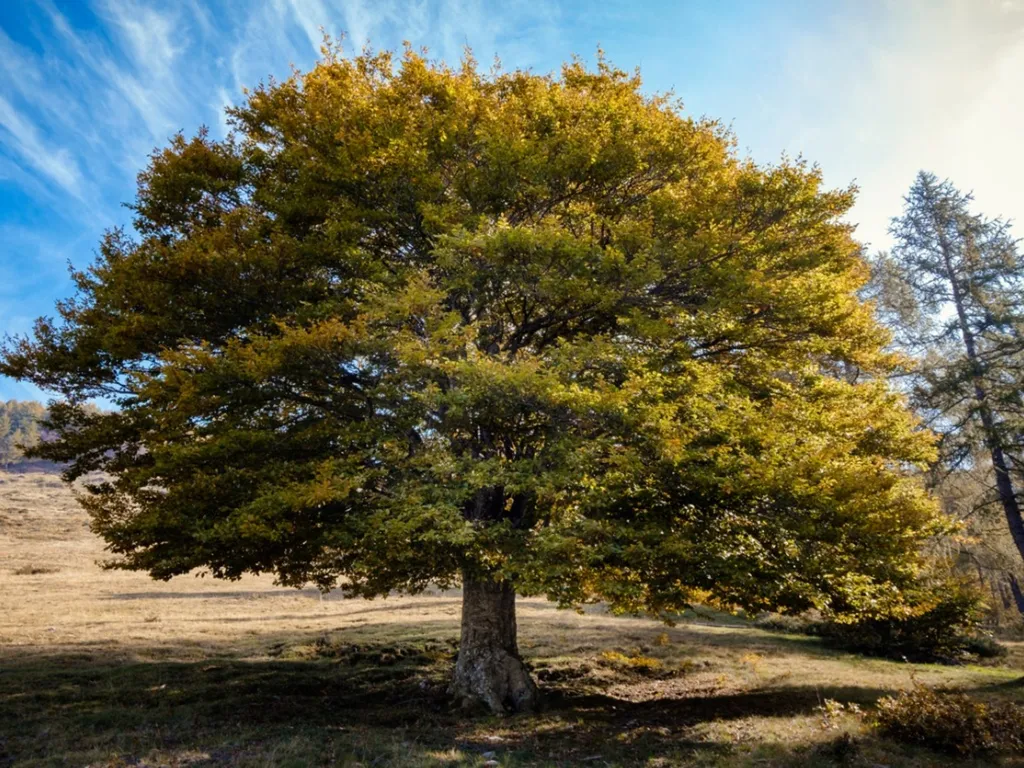Tóm tắt nội dung

Đáp án
| 14. C | 21. B |
|---|---|
| 15. G | 22. C |
| 16. B | 23. A |
| 17. E | 24. oak |
| 18. C | 25. flooring |
| 19. B | 26. keel |
| 20. A |
Bringing elms back to Britain
Mark Rowe investigates attempts to reintroduce elms to Britain
A Around 25 million elms, accounting for 90% of all elm trees in the UK, died during the 1960s and ’70s of Dutch elm disease. In the aftermath, the elm, once so dominant in the British landscape, was largely forgotten. However, there’s now hope the elm may be reintroduced to the countryside of central and southern England. Any reintroduction will start from a very low base. ‘The impact of the disease is difficult to picture if you hadn’t seen what was there before,’ (Q23) says Matt Elliot of the Woodland Trust. ‘You look at old photographs from the 1960s and it’s only then that you realise the impact [elms had] … They were significant, large trees… then they were gone’.
B The disease is caused by a fungus that blocks the elms’ vascular (water, nutrient and food transport) system, causing branches to wilt and die. A first epidemic, which occurred in the 1920s, gradually died down, but in the ’70s a second epidemic was triggered by shipments of elm from Canada. The wood came in the form of logs destined for boat building and its intact bark was perfect for the elm bark beetles that spread the deadly fungus. This time, the beetles carried a much more virulent strain that destroyed the vast majority of British elms. (Q16)
C Today, elms still exist in the southern English countryside but mostly only in low hedgerows between fields. ‘We have millions of small elms in hedgerows but they get targeted by the beetle as soon as they reach a certain size,’ says Karen Russell, co-author of the report ‘Where we are with elm’. Once the trunk of the elm reaches 10–15 centimetres or so in diameter, it becomes a perfect site for beetles to lay eggs and for the fungus to take hold. (Q18) Yet mature specimens have been identified, in counties such as Cambridgeshire, that are hundreds of years old, and have mysteriously escaped the epidemic. The key, Russell says, is to identify and study those trees that have survived and work out why they stood tall when millions of others succumbed. Nevertheless, opportunities are limited as the number of these mature survivors is relatively small. (Q14) ‘What are the reasons for their survival?’ asks Russell. ‘Avoidance, tolerance, resistance? We don’t know where the balance lies between the three. I don’t see how it can be entirely down to luck’. (Q21)
D For centuries, elm ran a close second to oak (Q24) as the hardwood tree of choice in Britain and was in many instances the most prominent tree in the landscape. Not only was elm common in European forests, it became a key component of birch, ash and hazel woodlands. The use of elm is thought to go back to the Bronze Age, when it was widely used for tools. Elm was also the preferred material for shields and early swords. In the 18th century, it was planted more widely and its wood was used for items such as storage crates and flooring (Q25). It was also suitable for items that experienced high levels of impact and was used to build the keel of the 19th-century sailing ship Cutty Sark (Q26) as well as mining equipment.
E Given how ingrained elm is in British culture, it’s unsurprising the tree has many advocates. Amongst them is Peter Bourne of the National Elm Collection in Brighton. ‘I saw Dutch elm disease unfold as a small boy,’ he says. ‘The elm seemed to be part of rural England, but I remember watching trees just lose their leaves and that really stayed with me’. Today, the city of Brighton’s elms total about 17,000. Local factors appear to have contributed to their survival. Strong winds from the sea make it difficult for the determined elm bark beetle to attack this coastal city’s elm population. (Q17) However, the situation is precarious. ‘The beetles can just march in if we’re not careful, as the threat is right on our doorstep,’ says Bourne. (Q22)
F Any prospect of the elm returning relies heavily on trees being either resistant to, or tolerant of, the disease. This means a widespread reintroduction would involve existing or new hybrid strains derived from resistant, generally non-native elm species. A new generation of seedlings have been bred and tested to see if they can withstand the fungus by cutting a small slit on the bark and injecting a tiny amount of the pathogen. ‘The effects are very quick,’ says Russell. ‘You return in four to six weeks and trees that are resistant show no symptoms, whereas those that are susceptible show leaf loss and may even have died completely’. (Q19)
G All of this raises questions of social acceptance, acknowledges Russell. ‘If we’re putting elm back into the landscape, a small element of it is not native – are we bothered about that?’ For her, the environmental case for reintroducing elm is strong. ‘They will host wildlife, which is a good thing.’ Others are more wary. ‘On the face of it, it seems like a good idea,’ says Elliot. The problem, he suggests, is that, ‘You’re replacing a native species with a horticultural analogue*. You’re effectively cloning’. (Q15) There’s also the risk of introducing new diseases. Rather than plant new elms, the Woodland Trust emphasises providing space to those elms that have survived independently. ‘Sometimes the best thing you can do is just give nature time to recover over time, you might get resistance,’ (Q20) says Elliot.
Questions 14–18
Which section contains the following information?
NB You may use any letter more than once
- Reference to the research problems that arise from there being only a few surviving large elms
- Details of a difference of opinion about the value of reintroducing elms to Britain
- Reference to how Dutch elm disease was brought into Britain
- A description of the conditions that have enabled a location in Britain to escape Dutch elm disease
- Reference to the stage at which young elms become vulnerable to Dutch elm disease
Questions 19–23
Match each statement with the correct person
- If a tree gets infected with Dutch elm disease, the damage rapidly becomes visible.
- It may be better to wait and see if the mature elms that have survived continue to flourish.
- There must be an explanation for the survival of some mature elms.
- We need to be aware that insects carrying Dutch elm disease are not very far away.
- You understand the effect Dutch elm disease has had when you see evidence of how prominent the tree once was.
| List of people
A Mark Elliot B Karen Russell C Peter Bourne |
Questions 24–26
Complete the summary below
Uses of a popular tree
For hundreds of years, the only tree that was more popular in Britain than elm was
- __________. Starting in the Bronze Age, many tools were made from elm and people also used it to make weapons. In the 18th century, it was grown to provide wood for boxes and 25. __________. Due to its strength, elm was often used for mining equipment and the Cutty Sark’s 26. __________ was also constructed from elm.
Giải thích chi tiết
| Câu hỏi | Đáp án | Từ khóa
trong câu hỏi |
Từ đồng nghĩa
trong bài |
Giải thích |
| 14 | C | Reference to the research problems that arise from there being only a few surviving large elms | The key, Russell says, is to identify and study those trees that have survived and work out why they stood tall when millions of others succumbed. Nevertheless, opportunities are limited as the number of these mature survivors is relatively small. | Russel cho rằng điều quan trọng nhất là phải xác định và nghiên cứu các cây đã sống sót và tìm hiểu tại sao chúng vẫn đứng hiên ngang trong khi hàng triệu cây khác đã chết. Tuy nhiên, cơ hội để làm việc này là rất hạn chế vì số lượng cây trưởng thành còn tồn tại là rất nhỏ. |
| 15 | G | Details of a difference of opinion about the value of reintroducing elms to Britain | ‘They will host wildlife, which is a good thing.’ Others are more wary. ‘On the face of it, it seems like a good idea,’ says Elliot. The problem, he suggests, is that, ‘You’re replacing a native species with a horticultural analogue*. You’re effectively cloning’. | Có một số ý kiến cho rằng chúng sẽ làm nơi trú ẩn cho động vật hoang dã, là một điều tốt. Tuy nhiên Elliot và một số khác cho rằng chúng có thể gây ra vấn đề. ‘Bạn đang thay thế một loài cây bản địa bằng một loài tương tự trong làm vườn. Bạn chỉ đang sao chép thôi’. |
| 16 | B | Reference to how Dutch elm disease was brought into Britain | A first epidemic, which occurred in the 1920s, gradually died down, but in the ’70s a second epidemic was triggered by shipments of elm from Canada. The wood came in the form of logs destined for boat building and its intact bark was perfect for the elm bark beetles that spread the deadly fungus. This time, the beetles carried a much more virulent strain that destroyed the vast majority of British elms. | Đợt dịch thứ hai vào những năm 1970 đã được kích hoạt bởi những chuyến tàu chở gỗ du từ Canada. Lần này những con bọ mang theo một chủng bệnh độc lực cao hơn nhiều, khiến phần lớn cây du ở Anh bị tàn phá. |
| 17 | E | A description of the conditions that have enabled a location in Britain to escape Dutch elm disease | Today, the city of Brighton‘s elms total about 17,000. Local factors appear to have contributed to their survival. Strong winds from the sea make it difficult for the determined elm bark beetle to attack this coastal city’s elm population. | Ngày nay, tổng cộng có 17,000 cây du ở thành phố Brighton. Các yếu tố địa phương có vẻ như đã đóng góp cho sự tồn tại của chúng. Những cơn gió mạnh từ biển thổi vào gây khó khăn cho những con bọ khi chúng cố gắng tấn công cây du ở thành phố ven biển này. |
| 18 | C | Reference to the stage at which young elms become vulnerable to Dutch elm disease | Once the trunk of the elm reaches 10–15 centimetres or so in diameter, it becomes a perfect site for beetles to lay eggs and for the fungus to take hold. | Một khi thân gây du đạt đường kính 10-15 cm, chúng trở thành nơi hoàn hảo cho bọ đẻ trứng và nấm mốc hoành hành. |
| 19 | B | If a tree gets infected with Dutch elm disease, the damage rapidly becomes visible. | … those that are susceptible show leaf loss and may even have died completely’. | … những cây dễ bị nhiễm bệnh cho thấy sự rụng lá và thậm chí chúng có thể đã chết hoàn toàn. ⇒ Karen Russell nói điều này. |
| 20 | A | It may be better to wait and see if the mature elms that have survived continue to flourish. | ‘Sometimes the best thing you can do is just give nature time to recover over time, … | ‘Thỉnh thoảng điều tốt nhất bạn có thể làm đơn giản là cho thiên nhiên thời gian để hồi phục, … ⇒ Mark Elliot nói điều này. |
| 21 | B | There must be an explanation for the survival of some mature elms. | ‘What are the reasons for their survival?’ asks Russell. ‘Avoidance, tolerance, resistance? We don’t know where the balance lies between the three. I don’t see how it can be entirely down to luck’. | ‘Những lý do gì giúp chúng sống sót?’ Russell hỏi. ‘Sự tránh né, khả năng chịu đựng, sự kháng cự? Chúng tôi không biết sự cân bằng giữa ba yếu tố này nằm ở đâu. Tôi không nghĩ rằng mọi thứ chỉ đơn thuần là do may mắn.’ ⇒ Karen Russell nói điều này. |
| 22 | C | We need to be aware that insects carrying Dutch elm disease are not very far away. | However, the situation is precarious. ‘The beetles can just march in if we’re not careful, as the threat is right on our doorstep,’ says Bourne. | Tuy nhiên, tình hình đang rất nguy cấp. ‘Lũ bọ cánh cứng có thể tràn vào bất cứ lúc nào nếu chúng ta không cẩn thận, vì mối đe dọa đang ở ngay trước mắt,’ ⇒ Peter Bourne nói điều này. |
| 23 | A | You understand the effect Dutch elm disease has had when you see evidence of how prominent the tree once was. | ‘The impact of the disease is difficult to picture if you hadn’t seen what was there before,’ … | ‘Sẽ rất khó hình dung sức ảnh hưởng của bệnh nếu như bạn chưa từng nhìn thấy những cái cây trước đây,’ [đã khỏe đẹp như thế nào] ⇒ Mark Elliot nói điều này. |
| 24 | oak | For hundreds of years, the only tree that was more popular in Britain than elm was __________. | For centuries, elm ran a close second to oak … | Trong nhiều thế kỷ, cây du luôn chỉ đứng sau cây sồi một chút… |
| 25 | flooring | In the 18th century, it was grown to provide wood for boxes and __________. | In the 18th century, it was planted more widely and its wood was used for items such as storage crates and flooring. | Vào thế kỷ 18, cây du được trồng rộng rãi hơn và gỗ của nó được dùng để làm các vật dụng như thùng đựng đồ và sàn nhà. |
| 26 | keel | Due to its strength, elm was often used for mining equipment and the Cutty Sark‘s __________ was also constructed from elm. | It was also suitable for items that experienced high levels of impact and was used to build the keel of the 19th-century sailing ship Cutty Sark as well as mining equipment. | Gỗ cây du cũng phù hợp để làm những vật dụng chịu va đập mạnh và đã được sử dụng để đóng sống tàu của con thuyền buồm thế kỷ 19 mang tên Cutty Sark, cũng như các thiết bị khai thác mỏ. |
Bài viết tương tự
Đón chờ các bài viết sắp tới tại thư viện IELTSITY nhé!












